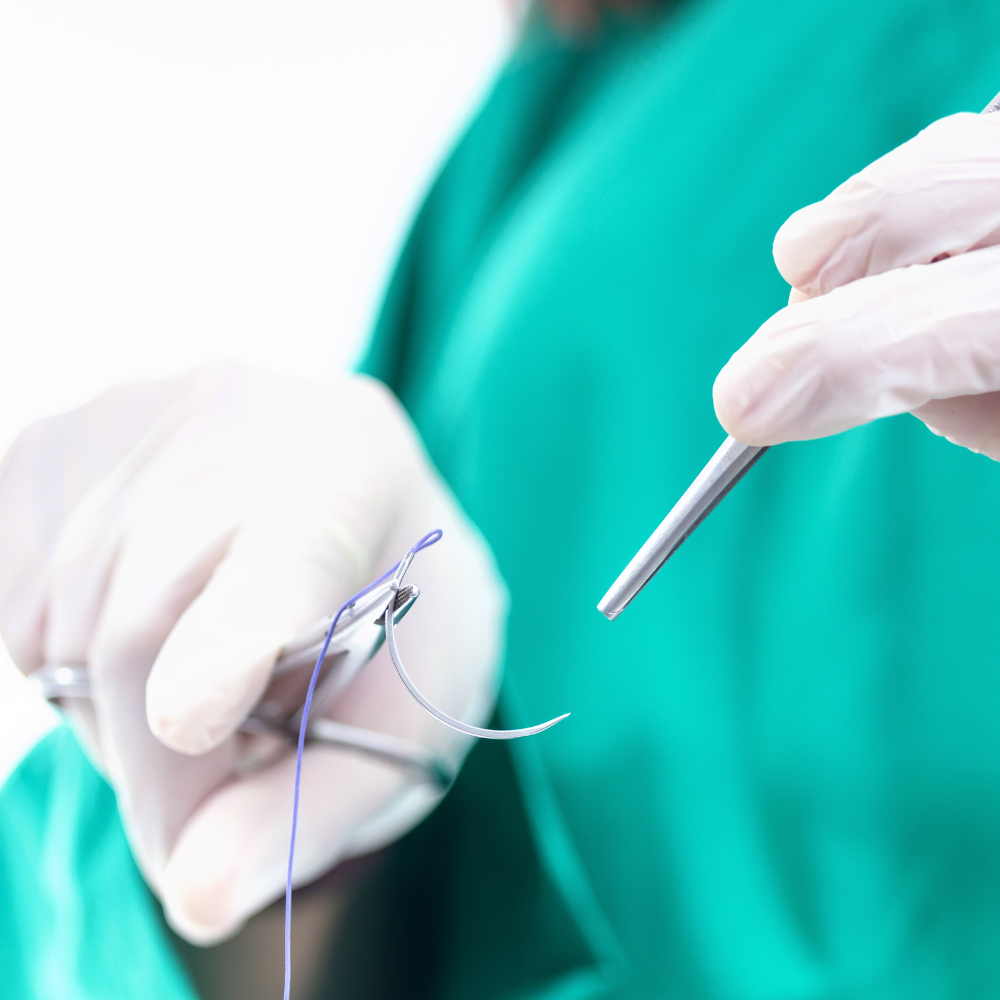Monofilament or polyfilament suture material: advantages and disadvantages at a glance
Medical suture material is available in many different versions. In addition to their absorbability, individual products differ in particular in terms of their thread structure: monofilament suture material is opposed to polyfilament suture material . Both types of thread have individual advantages and disadvantages that make them ideal for specific tasks. In the following overview, we present all the information about monofilament and polyfilament suture material and explain the respective advantages and disadvantages.
Table of contents
The thread structure: monofilament suture material versus polyfilament suture material
Monofilament suture material: The specific advantages and disadvantages
Polyfilament suture material: The specific advantages and disadvantages
Should I buy monofilament or polyfilament suture material?
The thread structure: monofilament suture material versus polyfilament suture material
The selection of the right suture material depends on various factors: Where exactly a wound closure is to be carried out can have just as much of an influence as the question of how large the wound is that has to be closed with the suture material. This is because the affected tissue, the type of wound closure and also the surgical technique as well as the wound tension can have a major influence on how the wound heals later.
For this reason, suture manufacturers are constantly developing new products that are characterized by better properties. In addition to the material origin and absorbability, the thread structure plays an important role . This is the decisive factor in determining
- handling of the suture material
- tissue penetration (additional traumatization of the tissue)
- knot seat
- capillarity (wicking effect)
Over time , two types of thread structure have become established in suture material: polyfilament and monofilament . The respective variants consist of either a single filament (fiber) or several filaments. Most manufacturers in our suture material shop offer both monofilament and polyfilament suture material .

Monofilament suture material: The specific advantages and disadvantages
Monofilament suture material consists of only a single filament or fiber. If it is synthetic monofilament suture material , it is usually produced using the so-called melt spinning process. This process makes it possible to spin threads consisting of only a single filament in any length. The biggest advantage of monofilament suture material is also its only disadvantage: the smooth surface.
Advantages of monofilament suture material
- optimal fabric penetration
- no sawing effect
- no capillarity
- smooth surface
Monofilament suture material has a smooth, completely closed surface , which enables excellent and soft tissue penetration without additional trauma. At the same time, the monofilament suture material prevents the dreaded capillarity or wicking effect from the outset due to its structure. This greatly reduces the risk of contamination or the spread of germs. Another advantage is the longitudinal elasticity of the monofilament suture material , although there are large differences in this regard between the products of individual manufacturers.
Disadvantages of monofilament suture material
The smooth surface of the monofilament suture material reduces the ability to tie knots and makes the knot fit worse . It is therefore often necessary to tie a larger number of knots with monofilament suture material. In addition, monofilament threads are somewhat less convenient to handle because they are less flexible. However, this disadvantage of monofilament suture material usually only affects thicker threads - the thinner the suture material, the more flexible it becomes. In addition, uncoated monofilament suture material has a surface that is susceptible to damage. This suture material must be handled with appropriate care.
Polyfilament suture material: The specific advantages and disadvantages
In contrast to monofilament suture material, polyfilament suture material consists of several filaments . Depending on the specific thread structure, several fibers are braided or twisted to form a complex thread. There are various variations in which the thread structure is usually made up of a filament core (thread core) and several individual filaments on top that are joined together to form bundles. In addition to some advantages, there are several disadvantages, particularly with uncoated polyfilament suture material .
Advantages of polyfilament suture material
- optimal knot fit
- good knotting ability
- easy handling thanks to high elasticity
The greatest advantage of polyfilament suture material is the excellent knot fit : Since uncoated polyfilament threads in particular have a rough surface, knots can be set quickly and precisely. At the same time, the knots hold optimally. The flexibility and elasticity of the polyfilament suture material is also impressive - this makes handling the thread much easier, even with thicker threads.
Disadvantages of polyfilament suture material
Uncoated twisted suture material in particular has a relatively high capillarity . This can lead to germs penetrating the wound and making wound healing significantly more difficult. With braided suture material, the capillarity is somewhat lower, but still significantly higher than with monofilament suture material. An additional coating of polyfilament suture material further reduces the wicking effect and is therefore often standard today.
Another disadvantage of polyfilament suture material is also due to the rough surface: when pulling through the tissue, a sawing effect occurs , which further traumatizes the tissue. Polyfilament threads without an additional coating are therefore not an option, especially in sensitive tissue regions.
Buy monofilament or polyfilament suture material
Monofilament suture material and polyfilament suture material both have individual advantages and disadvantages . The right thread must be chosen according to the specific application; a general recommendation as to which of the two types of thread is better cannot be made. In general, however, pseudomonofilament or coated multifilament (braided) suture materials are becoming increasingly popular. In principle, the properties of the suture material must be selected to suit the respective task. This applies not only to the thread structure, but also to the surgical needles used as suture material.


Resorbable suture material: All information at a glance